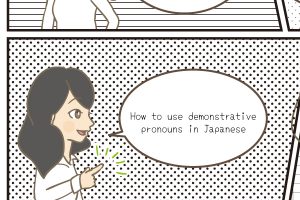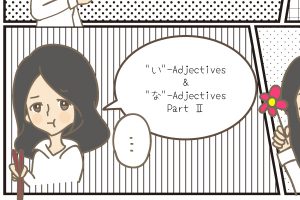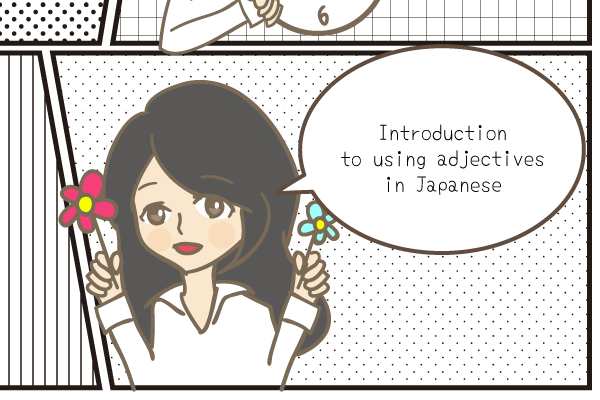Introduction to using adjectives in Japanese
Last time you learned how to use demonstrative pronouns in Japanese. This week Shiho explained about the different types of “形容詞” (adjectives) and how to use them in Japanese. Do you know the difference between “い”-adjectives and “な”-adjectives? If not, prepare to learn!
| Table of Contents [Adjectives in Japanese] [Negating Japanese adjectives: “い”-adjectives] [Negating Japanese adjectives: “な”-adjectives] [Exceptions] |
[Adjectives in Japanese]
In Japanese, there are two types of adjectives: “い”-adjectives and “な”-adjectives. “い”-adjectives, as the name suggests, end on the letter “i”. Here are some example for easy and frequently used “i”-adjectives:
| 大きい | Big |
| 高い | High, tall |
| おいしい | Delicious |
The second type are adjectives which (mostly) end on any other letter than “i” and need the syllable “na” in front of them to combine them directly with nouns. Here are some examples:
| きれい | Pretty |
| 便利 | Useful | すき | Like (please note how “to like”, a verb in English, is actually expressed as an adjective in Japanese) |
As you can see, “きれい” ends on an “i”, but is still considered a “な”-adjective. There are a few other exceptions like this (e.g. “ゆうめい”), which are grammatically “な”-adjectives even though they end on an “i”.
Tip: Most of these words (like “綺麗” and “有名”) can be written completely in Kanji. With proper “い”-adjectives, the “い” is usually written in Hiragana, like with “高い” or “大きい” – that is one way to figure out whether an adjective is a “な”-adjective or an “い”-adjective.
[Negating Japanese adjectives: “い”-adjectives]
Before negating the adjectives, let’s try building a few example sentences with them. Let’s start with “い”-adjectives.
| この犬は大きい。 | This dog is big. |
As you can see, you can use “い”-adjectives just the way they are – no need to adjust them, no matter where you use them in the sentence. Now, to negate the sentence:
| この犬は大きくない。 | This dog is not big. |
To negate “い”-adjectives, you transform the last letter “i” into “ku”. Then, you add the negator, which in this case is “ない”. Let’s try and negate our other examples:
| 高くない | Not expensive |
| おいしくない | Not delicious |
Now, saying “この犬は大きくない” is a very casual way of speaking. There are two ways to negate “い”-adjectives in a more formal and polite way.
| 大きくないです。 | This is a polite way of saying “not big”. |
| 大きくありません。 | This is a polite, but also very formal way of saying “not big”. |
As you can see, one way is to add “です” to the negator “ない”. The other way is to switch the negator “ない” to the more formal one “ありません”. Other examples:
| 高くないです 高くありません。 |
Not expensive |
| おいしくないです。 おいしくありません。 |
Not delicious |
[adsense]
[Negating Japanese adjectives: “な”-adjectives]
Now let’s take a look at “な”-adjectives. First of all, let’s practice by creating some normal sentences using “な”-adjectives:
| この花はきれいだ。 | This flower is pretty. |
| これはきれいな花だ。 | This is a pretty flower. |
| あなたがすきだ。 | I like you. *Again please note that the English verb “to like” is expressed as an adjective in Japanese. |
| これは便利だ。 | This is useful. |
Now, how do you negate “な”-adjectives? Let’s try and negate the sentences above:
| この花はきれいじゃない/ではない。 | This flower is not pretty. |
| これはきれいな花じゃない/ではない。 | This is not a pretty flower. |
In order to negate “な”-adjectives, you simply have to negate the verb of the sentence, which in this case is “だ” – to be. The negative form of “だ” is “じゃない” or a bit more formally “ではない”. Let’s do the other examples as well:
| あなたがすきじゃない/ではない。 | I don’t like you. |
| これは便利じゃない/ではない。 | This is not useful. |
Now, if you want to level up the politeness, “じゃ” and “では” stay the name, but you can exchange the “ない” behind both expressions for “ありません”:
| きれいじゃありません/ではありません。 | Not pretty |
| すきじゃありません/ではありません | Not liked |
| 便利じゃありません/ではありません | Not useful |
Please note that “ではありません” is considered politer and more formal than “じゃありません”. Additionally, both expressions are more commonly used in written language. In conversation, you can also use the following way to negate “な”-adjectives:
| きれいじゃないです/ではないです。 | Not pretty |
[Exceptions]
Of course there are exceptions from the rules for both “い”- and “な”-adjectives. One very important exception is “いい”, meaning “good” – a word you’ll probably use a lot, so listen up!
| いい | Good |
| よくない | Not good/bad |
Polite form:
| よくないです | よくありません |
That’s it for today! Make sure to watch the video as well to get the best value out of this lesson♪
| 形容詞 | Adjective |
| 特別 | Special |
| 否定 | Negation |
| 変える | To change |
| 質問 | Question |
| 当てはまる | To apply (e.g. a rule) |
| 例外 | Exception |

How to use demonstrative pronouns in Japanese

Introduction to using adjectives in Japanese Part 2



